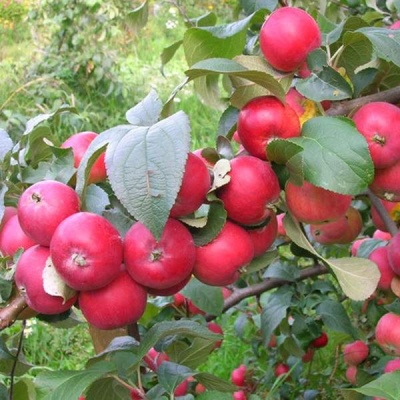
- Authors: Krasnoyarsk OSB, O.N. Lyubochko, N.N. Tikhonov, A.S. Tolmacheva
- Taste: sweet with a winey dessert shade
- Fruit weight, g: 60
- Fruit size: small
- Yield: up to 40-60 kg per tree
- The beginning of fruiting varieties: for 4-5 years
- Ripening terms: early autumn
- Removable maturity: early to mid September
- Keeping quality: up to 2 months
- Appointment: universal
Every gardener should definitely try to grow the Parent apple tree on his plot. The variety has a lot of advantages, while it is not capricious and does not require special care.
Description of the variety
The pupil is a fast-growing tree with a rounded crown. The foliage has an attractive sheen, does not have pubescence.
On the sunny side, the shoots show a red tint, where most of the time there is shade, they are brown. Many lentils are formed on them.
Features, pros and cons
If we talk about the advantages of this variety, then it is worth mentioning a stable yield, which, with proper care, can increase significantly. In addition, the Parent is a winter-hardy variety.
Among the disadvantages is the susceptibility to scab, therefore, processing is an important part of the complete care of the tree.
Ripening and fruiting
This variety is included in the early autumn group. In September, its removable maturity begins. The first fruits after planting can be harvested after 4-5 years.
Growing regions
Ideal conditions for raising the Pupils in the Krasnoyarsk Territory. The geography of distribution covers the following areas:
Irkutsk;
Novosibirsk;
Kemerovo;
Tyumen;
Omsk.
Yield
Yield should be judged only when the tree enters the full fruiting stage. This variety has this figure of 40-60 kg from one apple tree.
Fruits and their taste
Apples can be up to 60 grams. They are universally applicable. They are distinguished by a dark red color, flattened shape and a bloom in skin.
The Pupil is appreciated for its amazing dessert taste and light wine flavor.
Apples can stay in the refrigerator for up to 2 months, there are no problems with transportation.

Growing features
Apple trees of this variety require regular pruning, which is necessary not only to create a high-quality harvest, but also for aesthetic appeal, as well as the health of the tree. The best time of the year is early spring before the leaves appear on the tree.
If the grower sees dead or weak branches, they should be cut off. If the canopy of the apple tree seems too dense, you need to remove small shoots so that more sunlight penetrates into the crown.



Pollination
A pollinator is indispensable, otherwise the yield will suffer. The easiest way to solve the problem is to simply graft a different tree variety. You can plant a full-fledged tree, but it is imperative that it bloom at the same time as the Parent.
Top dressing
The amount of dressings depends on the quality of the soil where the apple tree is planted. If it is black soil, then the first few years there is no need for additional nutrients.
Experts advise to conduct a soil test before deciding which fertilizer to use. From it it will become clear which trace elements need to be replenished in the soil, and which ones should be abstained from for now. Excess is just as harmful to the Kindergarten as a deficiency of minerals.
Particular care must be taken with nitrogen, because if there is too much nitrogen in the soil, a lot of unnecessary greenery and shoots will appear on the tree, which will not bear fruit, but will take up nutrients and water.

Frost resistance
The variety is not afraid of frost and belongs to the category of winter-hardy varieties.

Diseases and pests
It is very important to be careful and inspect the leaves of the apple tree, revealing the first signs of powdery mildew. The disease can manifest itself at any stage of growth, in severe cases, in general, interfere with the formation of fruits.
As a preventive measure, it is advised to observe the distance between trees, prune in time, and use fungicides in the spring.
Apple scab, against which the variety has no immunity, attacks the tree quickly. The fruits become unusable. Sulfur-based fungicides to help the grower.
Another problem that one has to face when raising the Pupil is late blight rot. And in this case, proper planting and care will help to avoid infection. To prevent root rot, plant the apple trees in well-drained soil that is not too dense. Water should not be allowed to accumulate at the base of the tree, if there is stagnation of water on the site, you will have to plant the tree on a hill.

The apple tree is a popular fruit crop among gardeners. It can be found in many summer cottages. But at the same time, such trees are often affected by various diseases. It is very important to recognize the disease in time and carry out the necessary procedures for a speedy recovery. Otherwise, the fruits will be spoiled, and the tree itself may die altogether.












































































